Abstract
The high mobility group proteins (HMGs) are a class of low molecular weight, nonhistone, nuclear proteins that bind DNA and function as transcription cofactors. This class includes the HMGI family members HMGI-C and HMGI(Y). Both are not significantly expressed in differentiated adult tissues, including fat, but their expression is induced in proliferating and transformed cells. Their involvement in the development of lipomatous tumors has been recently demonstrated for HMGI-C, which is encoded by a gene located at 12q15, the chromosomal segment often rearranged in ordinary lipomas. The same chromosomal segment is consistently amplified in the ring and giant marker chromosomes of atypical lipomatous tumors (ALTs), a term used to designate tumors previously labeled as well differentiated liposarcomas or atypical lipomas. The involvement of HMGI(Y) is strongly suspected as the gene coding for HMGI(Y) is located at 6p21, a chromosomal segment rearranged in a subset of ordinary lipomas. HMGI-C or HMGI(Y) protein expression was analyzed immunohistochemically in a group of 39 well differentiated adipose neoplasms (19 lipomas and 20 ALTs) of known karyotype using polyclonal antibodies raised against a recombinant protein (HMGI-C) and against a synthetic peptide (HMGI(Y)). The results of this study demonstrate that HMGI proteins are commonly expressed in well differentiated adipose neoplasms. Seventeen of twenty ALTS (85.0%), all of which had ring or giant marker chromosomes with amplification of 12q13-15, strongly expressed HMGI-C. HMGI-C expression was detected in 7 of 11 ordinary lipomas (63.6%) with alterations at 12q14-15 and in one case with an abnormal karyotype that included double minute chromosomes. HMGI-C immunoreactivity correlates with 12q13-15 chromosomal alterations (P = 0.001). HMGI(Y) reactivity was demonstrated in only two ordinary lipomas: one with 6p21 rearrangement and one with normal karyotype. No significant HMGI(Y) expression was found in the ALT group. The finding of aberrant expression of HMGI proteins in well differentiated adipose neoplasms in association with 12q13-15 and 6p21 chromosomal changes supports the proposed pathogenetic role of this group of proteins in the development of adipose tissue tumors.
Full text
PDF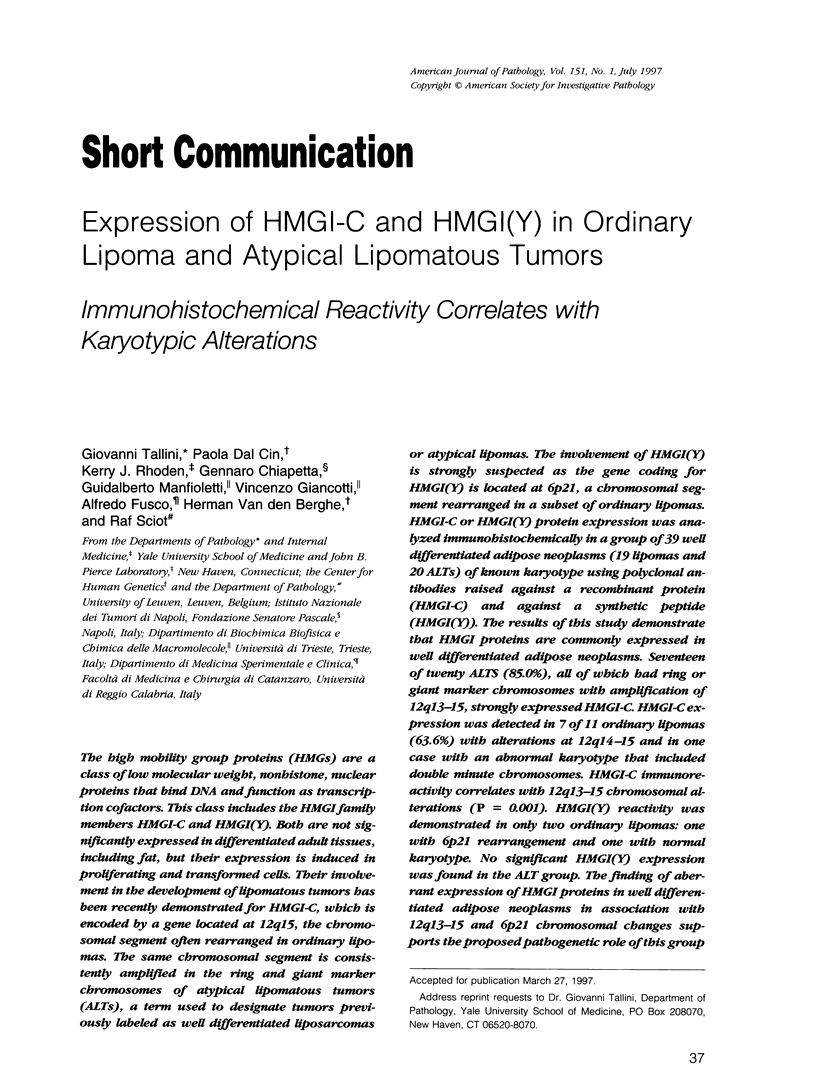
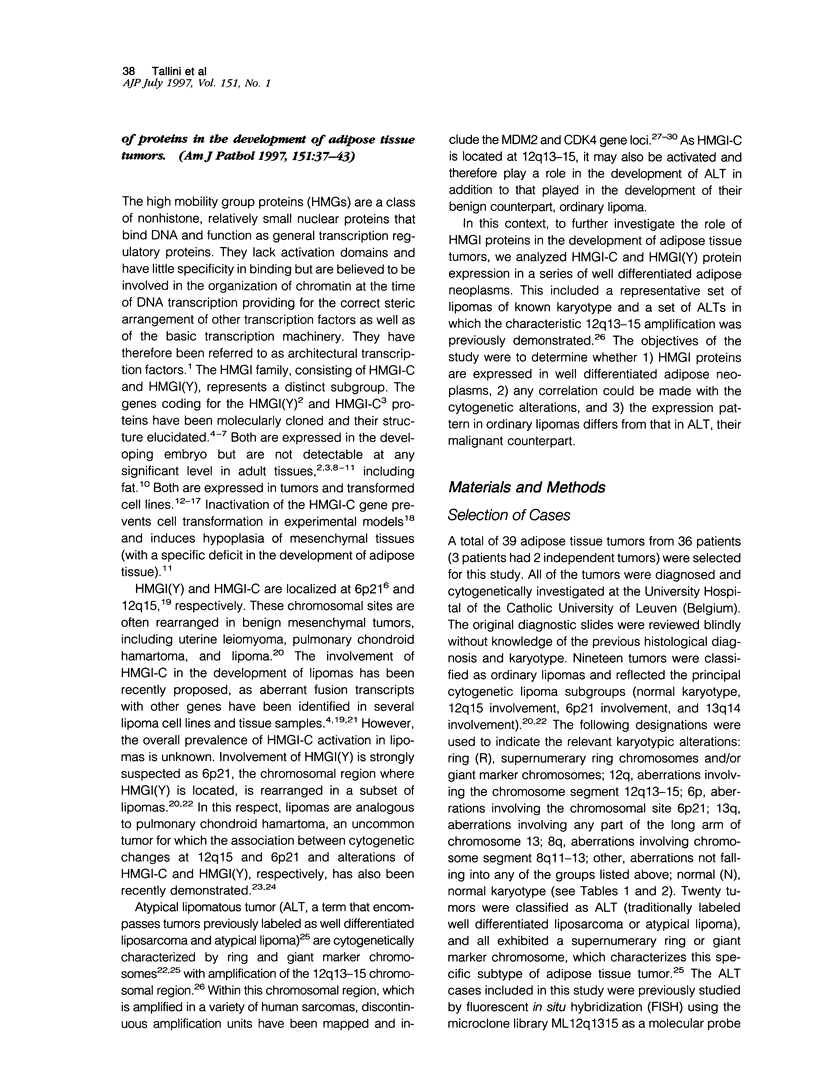
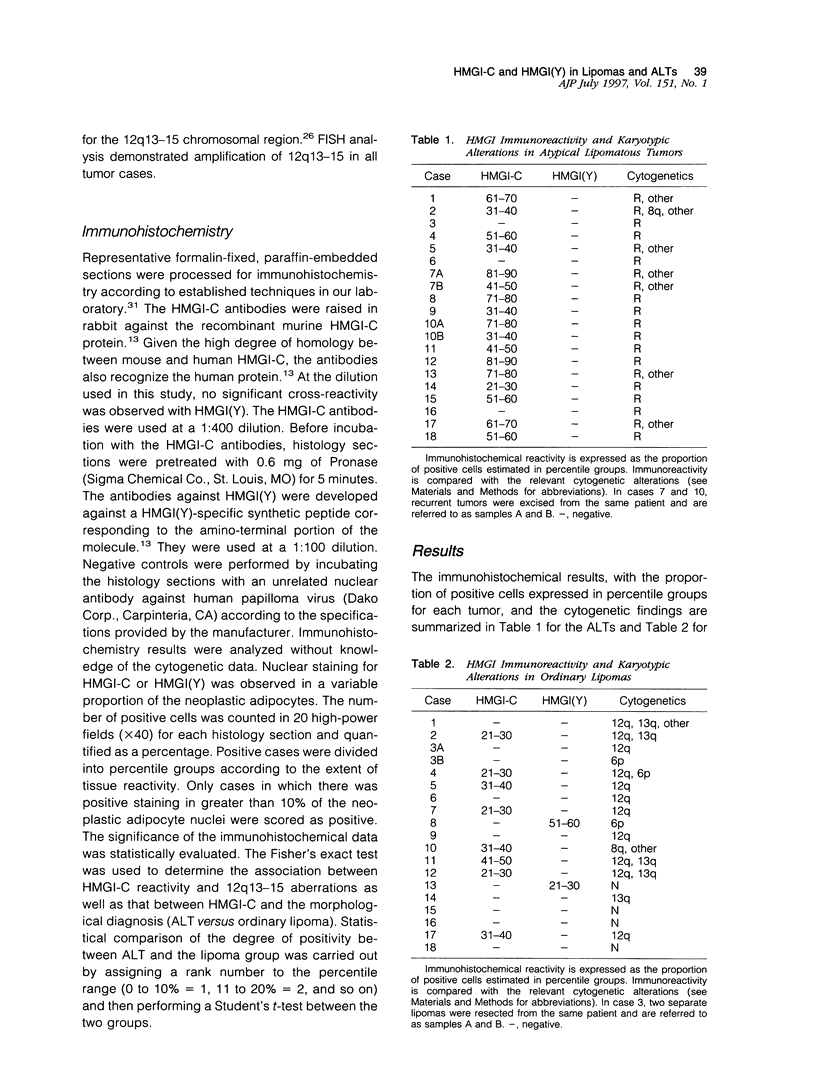
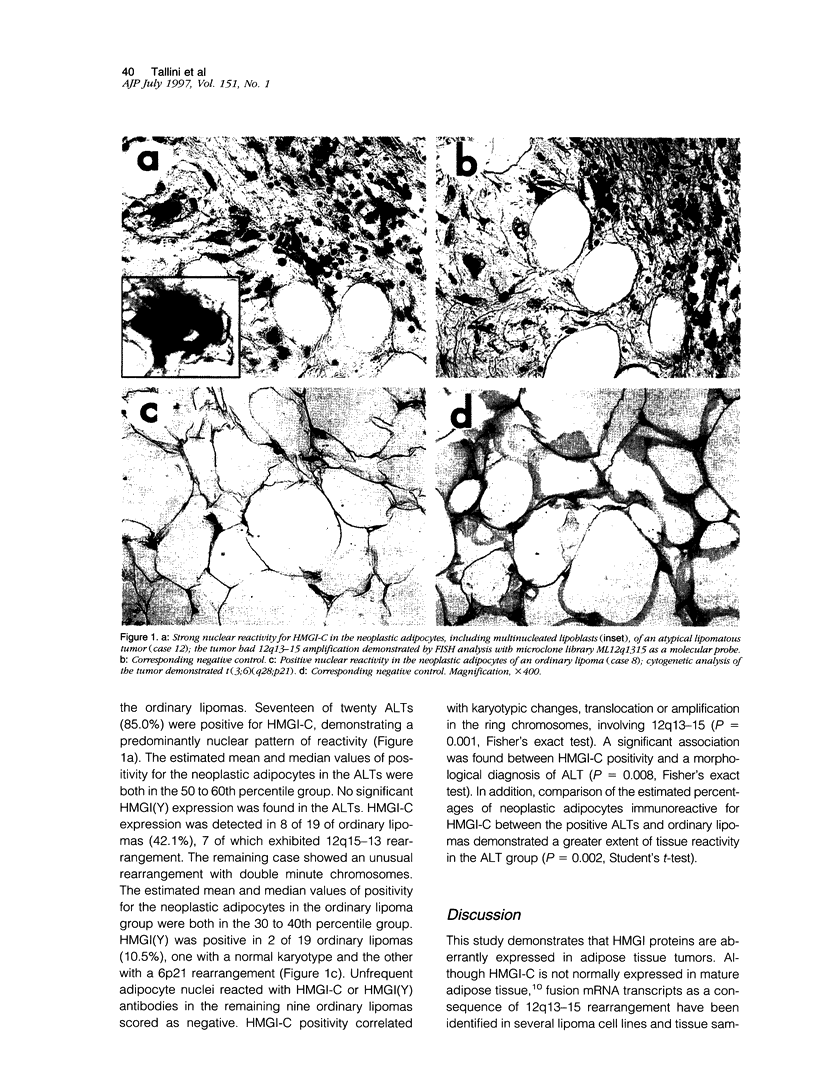
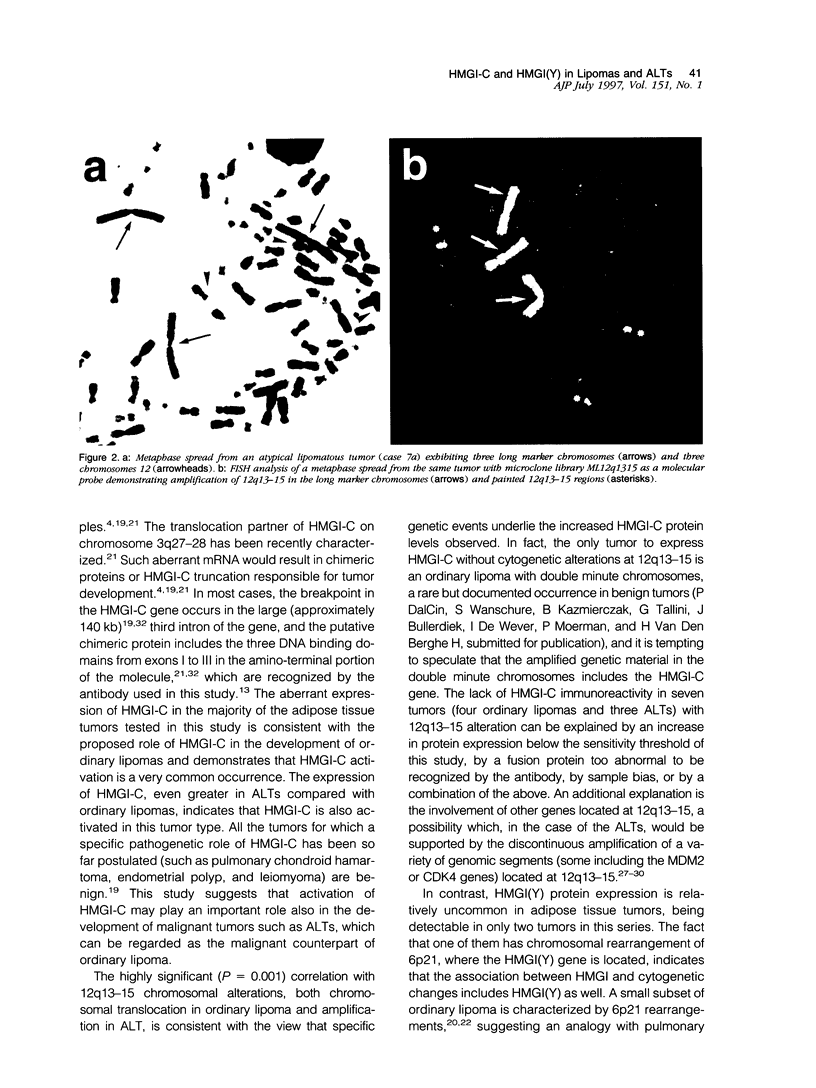
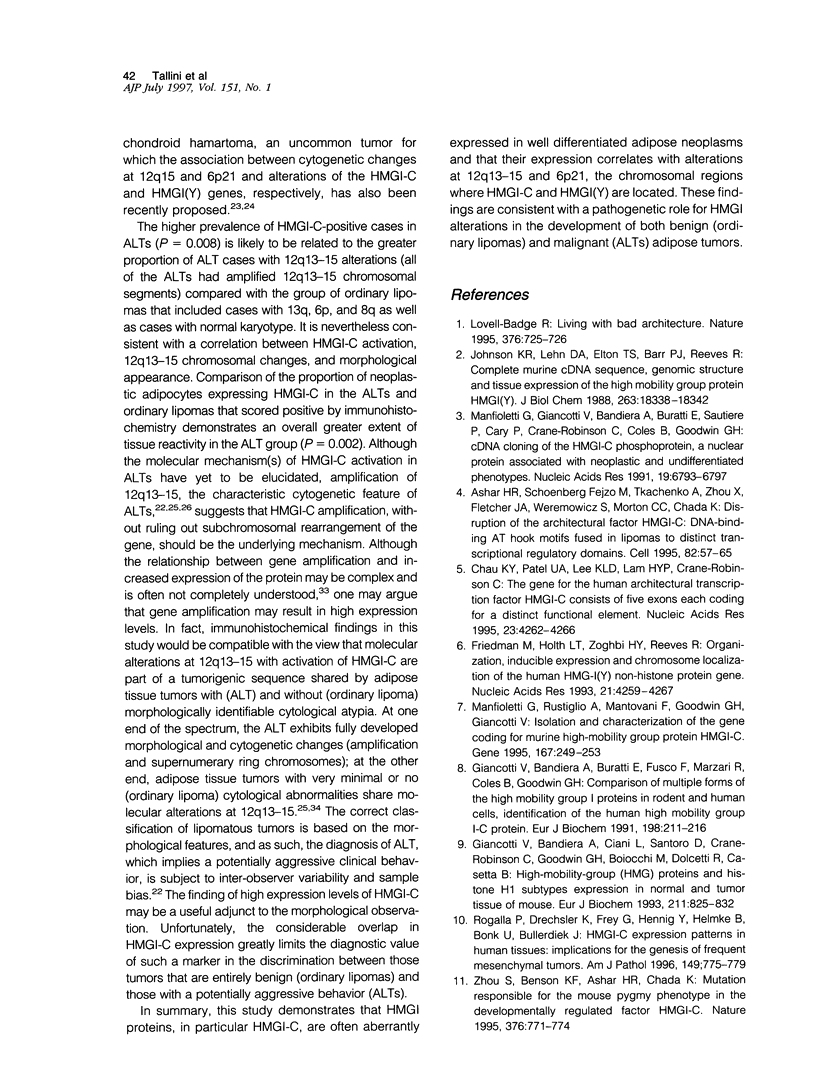
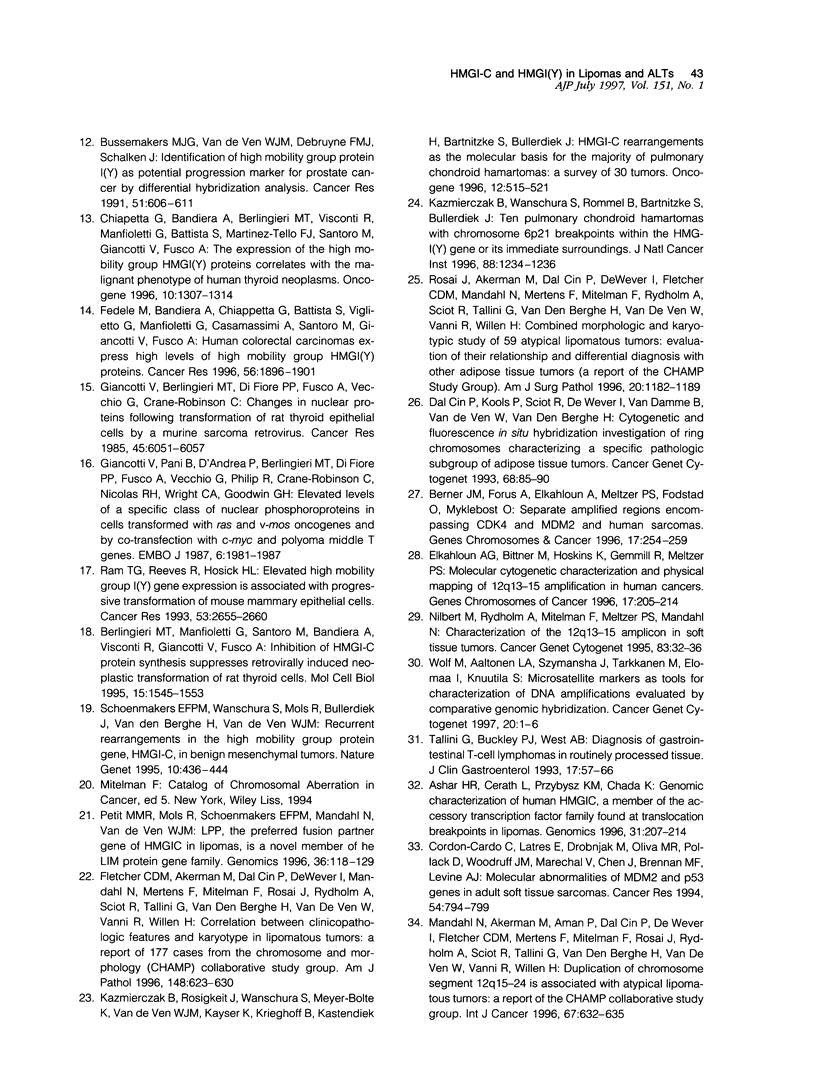
Images in this article
Selected References
These references are in PubMed. This may not be the complete list of references from this article.
- Ashar H. R., Cherath L., Przybysz K. M., Chada K. Genomic characterization of human HMGIC, a member of the accessory transcription factor family found at translocation breakpoints in lipomas. Genomics. 1996 Jan 15;31(2):207–214. doi: 10.1006/geno.1996.0033. [DOI] [PubMed] [Google Scholar]
- Ashar H. R., Fejzo M. S., Tkachenko A., Zhou X., Fletcher J. A., Weremowicz S., Morton C. C., Chada K. Disruption of the architectural factor HMGI-C: DNA-binding AT hook motifs fused in lipomas to distinct transcriptional regulatory domains. Cell. 1995 Jul 14;82(1):57–65. doi: 10.1016/0092-8674(95)90052-7. [DOI] [PubMed] [Google Scholar]
- Berlingieri M. T., Manfioletti G., Santoro M., Bandiera A., Visconti R., Giancotti V., Fusco A. Inhibition of HMGI-C protein synthesis suppresses retrovirally induced neoplastic transformation of rat thyroid cells. Mol Cell Biol. 1995 Mar;15(3):1545–1553. doi: 10.1128/mcb.15.3.1545. [DOI] [PMC free article] [PubMed] [Google Scholar] [Retracted]
- Berner J. M., Forus A., Elkahloun A., Meltzer P. S., Fodstad O., Myklebost O. Separate amplified regions encompassing CDK4 and MDM2 in human sarcomas. Genes Chromosomes Cancer. 1996 Dec;17(4):254–259. doi: 10.1002/(SICI)1098-2264(199612)17:4<254::AID-GCC7>3.0.CO;2-2. [DOI] [PubMed] [Google Scholar]
- Bussemakers M. J., van de Ven W. J., Debruyne F. M., Schalken J. A. Identification of high mobility group protein I(Y) as potential progression marker for prostate cancer by differential hybridization analysis. Cancer Res. 1991 Jan 15;51(2):606–611. [PubMed] [Google Scholar]
- Chau K. Y., Patel U. A., Lee K. L., Lam H. Y., Crane-Robinson C. The gene for the human architectural transcription factor HMGI-C consists of five exons each coding for a distinct functional element. Nucleic Acids Res. 1995 Nov 11;23(21):4262–4266. doi: 10.1093/nar/23.21.4262. [DOI] [PMC free article] [PubMed] [Google Scholar]
- Chiappetta G., Bandiera A., Berlingieri M. T., Visconti R., Manfioletti G., Battista S., Martinez-Tello F. J., Santoro M., Giancotti V., Fusco A. The expression of the high mobility group HMGI (Y) proteins correlates with the malignant phenotype of human thyroid neoplasias. Oncogene. 1995 Apr 6;10(7):1307–1314. [PubMed] [Google Scholar]
- Cordon-Cardo C., Latres E., Drobnjak M., Oliva M. R., Pollack D., Woodruff J. M., Marechal V., Chen J., Brennan M. F., Levine A. J. Molecular abnormalities of mdm2 and p53 genes in adult soft tissue sarcomas. Cancer Res. 1994 Feb 1;54(3):794–799. [PubMed] [Google Scholar]
- Dal Cin P., Kools P., Sciot R., De Wever I., Van Damme B., Van de Ven W., Van den Berghe H. Cytogenetic and fluorescence in situ hybridization investigation of ring chromosomes characterizing a specific pathologic subgroup of adipose tissue tumors. Cancer Genet Cytogenet. 1993 Jul 15;68(2):85–90. doi: 10.1016/0165-4608(93)90001-3. [DOI] [PubMed] [Google Scholar]
- Elkahloun A. G., Bittner M., Hoskins K., Gemmill R., Meltzer P. S. Molecular cytogenetic characterization and physical mapping of 12q13-15 amplification in human cancers. Genes Chromosomes Cancer. 1996 Dec;17(4):205–214. doi: 10.1002/(SICI)1098-2264(199612)17:4<205::AID-GCC2>3.0.CO;2-7. [DOI] [PubMed] [Google Scholar]
- Fedele M., Bandiera A., Chiappetta G., Battista S., Viglietto G., Manfioletti G., Casamassimi A., Santoro M., Giancotti V., Fusco A. Human colorectal carcinomas express high levels of high mobility group HMGI(Y) proteins. Cancer Res. 1996 Apr 15;56(8):1896–1901. [PubMed] [Google Scholar]
- Fletcher C. D., Akerman M., Dal Cin P., de Wever I., Mandahl N., Mertens F., Mitelman F., Rosai J., Rydholm A., Sciot R. Correlation between clinicopathological features and karyotype in lipomatous tumors. A report of 178 cases from the Chromosomes and Morphology (CHAMP) Collaborative Study Group. Am J Pathol. 1996 Feb;148(2):623–630. [PMC free article] [PubMed] [Google Scholar]
- Friedmann M., Holth L. T., Zoghbi H. Y., Reeves R. Organization, inducible-expression and chromosome localization of the human HMG-I(Y) nonhistone protein gene. Nucleic Acids Res. 1993 Sep 11;21(18):4259–4267. doi: 10.1093/nar/21.18.4259. [DOI] [PMC free article] [PubMed] [Google Scholar]
- Giancotti V., Bandiera A., Buratti E., Fusco A., Marzari R., Coles B., Goodwin G. H. Comparison of multiple forms of the high mobility group I proteins in rodent and human cells. Identification of the human high mobility group I-C protein. Eur J Biochem. 1991 May 23;198(1):211–216. doi: 10.1111/j.1432-1033.1991.tb16003.x. [DOI] [PubMed] [Google Scholar]
- Giancotti V., Bandiera A., Ciani L., Santoro D., Crane-Robinson C., Goodwin G. H., Boiocchi M., Dolcetti R., Casetta B. High-mobility-group (HMG) proteins and histone H1 subtypes expression in normal and tumor tissues of mouse. Eur J Biochem. 1993 Apr 15;213(2):825–832. doi: 10.1111/j.1432-1033.1993.tb17825.x. [DOI] [PubMed] [Google Scholar]
- Giancotti V., Berlingieri M. T., DiFiore P. P., Fusco A., Vecchio G., Crane-Robinson C. Changes in nuclear proteins on transformation of rat epithelial thyroid cells by a murine sarcoma retrovirus. Cancer Res. 1985 Dec;45(12 Pt 1):6051–6057. [PubMed] [Google Scholar]
- Giancotti V., Pani B., D'Andrea P., Berlingieri M. T., Di Fiore P. P., Fusco A., Vecchio G., Philp R., Crane-Robinson C., Nicolas R. H. Elevated levels of a specific class of nuclear phosphoproteins in cells transformed with v-ras and v-mos oncogenes and by cotransfection with c-myc and polyoma middle T genes. EMBO J. 1987 Jul;6(7):1981–1987. doi: 10.1002/j.1460-2075.1987.tb02461.x. [DOI] [PMC free article] [PubMed] [Google Scholar]
- Johnson K. R., Lehn D. A., Elton T. S., Barr P. J., Reeves R. Complete murine cDNA sequence, genomic structure, and tissue expression of the high mobility group protein HMG-I(Y). J Biol Chem. 1988 Dec 5;263(34):18338–18342. [PubMed] [Google Scholar]
- Kazmierczak B., Rosigkeit J., Wanschura S., Meyer-Bolte K., Van de Ven W. J., Kayser K., Krieghoff B., Kastendiek H., Bartnitzke S., Bullerdiek J. HMGI-C rearrangements as the molecular basis for the majority of pulmonary chondroid hamartomas: a survey of 30 tumors. Oncogene. 1996 Feb 1;12(3):515–521. [PubMed] [Google Scholar]
- Kazmierczak B., Wanschura S., Rommel B., Bartnitzke S., Bullerdiek J. Ten pulmonary chondroid hamartomas with chromosome 6p21 breakpoints within the HMG-I(Y) gene or its immediate surroundings. J Natl Cancer Inst. 1996 Sep 4;88(17):1234–1236. doi: 10.1093/jnci/88.17.1234. [DOI] [PubMed] [Google Scholar]
- Lovell-Badge R. Developmental genetics. Living with bad architecture. Nature. 1995 Aug 31;376(6543):725–726. doi: 10.1038/376725a0. [DOI] [PubMed] [Google Scholar]
- Mandahl N., Akerman M., Aman P., Dal Cin P., De Wever I., Fletcher C. D., Mertens F., Mitelman F., Rosai J., Rydholm A. Duplication of chromosome segment 12q15-24 is associated with atypical lipomatous tumors: a report of the CHAMP collaborative study group. CHromosomes And MorPhology. Int J Cancer. 1996 Sep 4;67(5):632–635. doi: 10.1002/(SICI)1097-0215(19960904)67:5<632::AID-IJC7>3.0.CO;2-V. [DOI] [PubMed] [Google Scholar]
- Manfioletti G., Giancotti V., Bandiera A., Buratti E., Sautière P., Cary P., Crane-Robinson C., Coles B., Goodwin G. H. cDNA cloning of the HMGI-C phosphoprotein, a nuclear protein associated with neoplastic and undifferentiated phenotypes. Nucleic Acids Res. 1991 Dec 25;19(24):6793–6797. doi: 10.1093/nar/19.24.6793. [DOI] [PMC free article] [PubMed] [Google Scholar]
- Manfioletti G., Rustighi A., Mantovani F., Goodwin G. H., Giancotti V. Isolation and characterization of the gene coding for murine high-mobility-group protein HMGI-C. Gene. 1995 Dec 29;167(1-2):249–253. doi: 10.1016/0378-1119(95)00666-4. [DOI] [PubMed] [Google Scholar]
- Nilbert M., Rydholm A., Mitelman F., Meltzer P. S., Mandahl N. Characterization of the 12q13-15 amplicon in soft tissue tumors. Cancer Genet Cytogenet. 1995 Aug;83(1):32–36. doi: 10.1016/s0165-4608(95)00016-x. [DOI] [PubMed] [Google Scholar]
- Petit M. M., Mols R., Schoenmakers E. F., Mandahl N., Van de Ven W. J. LPP, the preferred fusion partner gene of HMGIC in lipomas, is a novel member of the LIM protein gene family. Genomics. 1996 Aug 15;36(1):118–129. doi: 10.1006/geno.1996.0432. [DOI] [PubMed] [Google Scholar]
- Ram T. G., Reeves R., Hosick H. L. Elevated high mobility group-I(Y) gene expression is associated with progressive transformation of mouse mammary epithelial cells. Cancer Res. 1993 Jun 1;53(11):2655–2660. [PubMed] [Google Scholar]
- Rogalla P., Drechsler K., Frey G., Hennig Y., Helmke B., Bonk U., Bullerdiek J. HMGI-C expression patterns in human tissues. Implications for the genesis of frequent mesenchymal tumors. Am J Pathol. 1996 Sep;149(3):775–779. [PMC free article] [PubMed] [Google Scholar]
- Rosai J., Akerman M., Dal Cin P., DeWever I., Fletcher C. D., Mandahl N., Mertens F., Mitelman F., Rydholm A., Sciot R. Combined morphologic and karyotypic study of 59 atypical lipomatous tumors. Evaluation of their relationship and differential diagnosis with other adipose tissue tumors (a report of the CHAMP Study Group). Am J Surg Pathol. 1996 Oct;20(10):1182–1189. doi: 10.1097/00000478-199610000-00002. [DOI] [PubMed] [Google Scholar]
- Schoenmakers E. F., Wanschura S., Mols R., Bullerdiek J., Van den Berghe H., Van de Ven W. J. Recurrent rearrangements in the high mobility group protein gene, HMGI-C, in benign mesenchymal tumours. Nat Genet. 1995 Aug;10(4):436–444. doi: 10.1038/ng0895-436. [DOI] [PubMed] [Google Scholar]
- Tallini G., West A. B., Buckley P. J. Diagnosis of gastrointestinal T-cell lymphomas in routinely processed tissues. J Clin Gastroenterol. 1993 Jul;17(1):57–66. doi: 10.1097/00004836-199307000-00016. [DOI] [PubMed] [Google Scholar]
- Zhou X., Benson K. F., Ashar H. R., Chada K. Mutation responsible for the mouse pygmy phenotype in the developmentally regulated factor HMGI-C. Nature. 1995 Aug 31;376(6543):771–774. doi: 10.1038/376771a0. [DOI] [PubMed] [Google Scholar]




